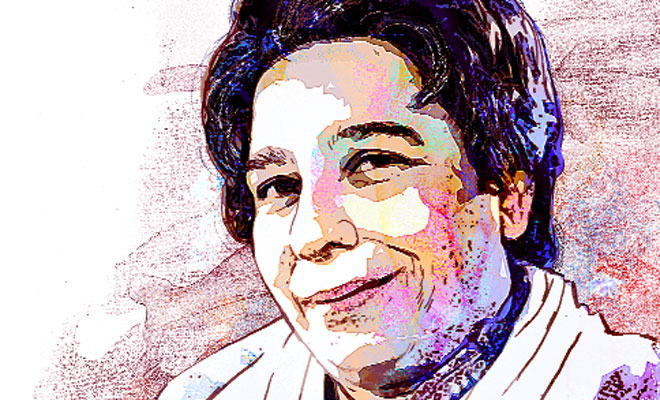Shamshad Begum, born on April 14, 1919 in Lahore, was arguably the first ever playback singer to become a star in her own right. Well before the advent of Lata Mangeshkar, she made a name for hersef, first in Lahore and then subsequently in Bombay. As every music director worth his salt wanted Shamshad to sing for him, it is said she charged an astronomical (then) Rs 1000 a song in the 1940s! She is also perhaps the most re-mixed artiste in recent times.
It was music maestro Master Ghulam Haider who discovered Shamshad, who used to sing on All India Radio, Lahore and Peshawar from 1937 onwards. He gave her a break in films with the Punjabi film, Yamla Jat (1940). However, Shamshad’s career really took off the following year with Khazanchi (1941), where her throaty vocals (OP Nayyar equated the clarity in her voice with tinkling temple bells) helped Ghulam Haider create a catchy musical score incorporating the dholak and Punjabi beats. Hindi film music would never be the same again. We start with a landmark song of Khazanchi – a duet by Shamshad and Haider himself in a situation that became a cliché in itself – a group of girls on cycles, a group of boys on cycles and by end of the song, wham! They bang into each other and boy meets girl! Talk about the Big Bang theory!
When Haider shifted to Bombay, Shamshad too left Lahore for the city of dreams as part of his group. Even as she sang for composers like Shyam Sunder, Khemchand Prakash and of course, Haider saab, Shamshad made it really big on the National scene once she started singing for Naushad. The team was formidable. Many of Naushad’s successes in the 1940s and early ’50s owe their popularity to Shamshad Begum. Here is a beautiful number composed by Naushad and picturized on Naseem Banu in Mehboob Khan’s Anokhi Ada (1948).
One of the first music directors to utilize the joyous gay abandon in Shamshad Begum’s voice was C Ramchandra. In fact, Shamshad helped kickstart the musical careers of several composers like Ramchandra and Madan Mohan only to see them leave her for Lata Mangeshkar once they become successful. Even Naushad, who had made her his main female playback singer by the late 1940s, swam thereafter with the Lata wave. Still, this Ramchandra composition from Patanga (1949) sees Shamshad at her matchless best and shows just what life and vibrancy she could breathe into a song.
SD Burman’s breakthrough film, Shabnam (1949), too was largely dependent on Shamshad’s earthy singing to take it through. A highlight of the film remains this multi-lingual song with different folk flavors of India running through it. It represents some of the best singing that Shamshad Begum has ever done. And all together! Remember in those days if there was any mistake, the whole song had to recorded from scratch unlike today where with unlimited tracks, they do it in sections, bit by bit.
https://www.youtube.com/watch?v=XmzI4T6kmVc
Bahar (1951) saw another successful teaming of Burman Dada and Shamshad with each song better than the other. Add to it the young Vyjayanthimala’s lively dancing and you have a classic for down the ages.
By now, Shamshad had lost ground not just to Lata Mangeshkar but also to Geeta Dutt as her nasal Punjabi voice was beginning to get obsolete in the 1950s. But fortunately for her, there was OP Nayyar. There was something freewheeling and a sense of joyfulness in the way OP Nayyar used Shamshad Begum’s vocals. Nothing illustrates this better than this lovely ditty in Guru Dutt’s Aar Paar (1954).
The Guru Dutt-OP Nayyar-Shamshad Begum combo back again and in fine form in another atmospheric song – this one from Mr and Mrs 55 (1955).
Even as there was a decline in the number of songs she was recording, Shamshad still made the best of whatever opportunities she was given. One of the last Hindi films ,where she made a major impact was Mehboob’s Mother India (1957). Here’s a lovely song featuring her familiar vocals from the film.
https://www.youtube.com/watch?v=xm0PZ1de9Rs
By the late 1950s and into the 1960s, Shamshad began to be heard less and less frequently on the Hindi film scenario. Still, she made one grand comeback thanks to OP Nayyar in this great number for Manmohan Desai’s Kismet (1968), where she is a hoot as she sings for Biswajeet in drag.
https://www.youtube.com/watch?v=He8ik3RYL4Q
Thankfully, Hindi cinema’s loss became Punjabi filmdom’s gain. In the late 1950s and through the 1960s, Shamshad Begum became the leading female playback singer in Punjabi films. Here’s one of her most popular songs filmed on Nishi from the Punjabi film Bhangra (1959).


